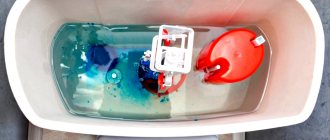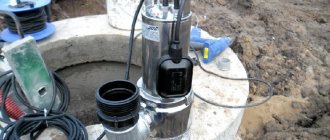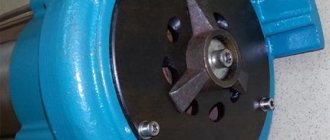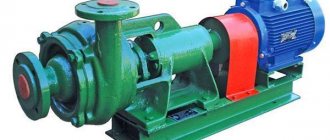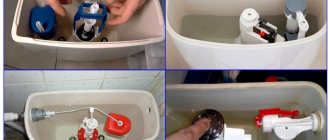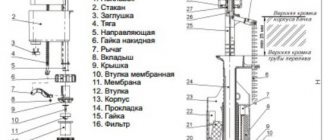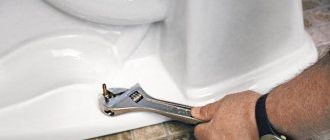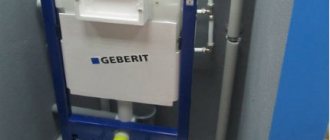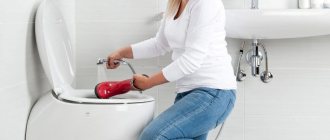Even the most reliable plumbing fixture can break down. It is especially unpleasant if this product is used daily by all family members. If the toilet cistern fittings have failed, you don’t want to wait a couple of days for a plumber to come, don’t you agree? Moreover, such a problem can be successfully solved on your own.
Before you begin the repair, you need to understand the design of the tank, the structure of the drain mechanism and understand the principle of operation of the drain. The article discusses in detail all of the above points, and also describes possible breakdowns of the toilet fittings and how to eliminate them.
Types of shut-off valves
Typically, toilet flush fittings are made of particularly durable plastic.
It is distinguished by its positive characteristics:
- Durability;
- Never rusts;
- Not exposed to aggressive environments;
- High strength;
- Easy maintenance.
The design of modern shut-off valves for toilets has several types:
- Combined;
- Separate.
A few years ago, tank mechanisms only featured one split configuration. Each valve was mounted separately. They performed the work autonomously, independent of each other. A float was installed to adjust the fill valve.
After the water rises to a certain level, the plastic float begins to rise under its pressure, and the water supply is cut off.
The drain neck is equipped with a valve that differs in its design. It is divided into:
- Mechanical;
- Air.
The valve is usually controlled by a mechanical button. It is easy to install the toilet fittings yourself, having first studied the structure of the entire structure.
Good to know! The most important advantage of the shut-off system is the replacement of fittings in the toilet cistern if it breaks. There is no need to change all components; it is enough to repair (replace) the damaged part. That is why such systems remain the most popular today.
Operating principle of the drainage device
The drainage device of the toilet tank is put into operation by the user acting on the external mechanism of the fittings. Moreover, depending on the principle of operation of the mechanism, the design itself will differ.
Features of the tank drain function
Among the operating elements used to activate the flush function are:
- button;
- lever arm;
- pedal.
The most common option is a button. Moreover, there are models of fittings with one or 2 different buttons - for releasing small and large volumes of working fluid. 2 flush versions allow you to save not only the planet’s water resource, but also reduce your monthly water supply payment.
Buttons are most often used in built-in models of drain devices and in compact earthenware products
When a button or lever is pressed, a thrust is generated that opens the drain valve. Water from a container with a volume of 10-12 liters rushes down into the toilet bowl, cleaning it and flushing away everything that was in it before.
The lever for controlling the flush can be very skillfully made and stylized as metal. For example, bronze, steel and others
How is filling done?
Simultaneously with the emptying of the tank, the float lowers, which leads to the opening of the valve that shut off the water supply from the water supply system. Water gradually fills the container and as soon as the float is at a certain level, previously set by the user, the float rod will completely shut off the water supply to the toilet flush tank.
Models of tanks with pneumatic drive are still found in everyday use. This flushing mechanism is especially convenient for people with disabilities and children.
How does overfill protection work?
When a failure occurs in the process of supplying the working fluid or one of the valve mechanisms fails, a safety device—overflow—is triggered. This is an empty tube that connects to the drain valve.
The principle of its operation is simple - as soon as the water level in the tank becomes higher than permissible, the water will begin to overflow into this tube and flow into the toilet bowl.
The height of the upper bell of the overflow tube is 1-1.5 cm greater than the water level in the tank set by the user
Premium fittings
For luxury plumbing, manufacturers produce shut-off valves for toilets of a completely different design. It has one system in which the drain valve is connected to the fill valve.
Adjusting the toilet fittings of this class is highly complex. However, if everything is configured correctly, the unit will operate without failures for a long time.
Note! The only drawback of this fitting is that in case of breakdown, it must be completely replaced. Repairing such a block is very difficult.
The essence of the cistern
Any toilet flush cistern is the most important working unit of the unit. The element provides water supply and sewage drainage. The part is a tank with holes for water inlet, outlet, and control levers. Inside the container there is fittings for the toilet cistern. This is a working mechanism.
The top of the tank is closed with a lid. The structure not only contains a functioning mechanism, but also serves as a storage facility for water. Externally, the part resembles an ergonomic tank connected to pipes and a sanitary bowl.
Reinforcement material
Factories producing such devices use various polymer materials.
The quality of the plastic depends on:
- Lifetime;
- Reliability;
- Strength;
- Safety.
The fittings are made of metal, which ensures high strength and long service life.
Materials for any toilet fittings are characterized by:
- Moisture resistance;
- Anti-corrosion properties;
- High strength;
- Ability to withstand heavy loads.
General steel reinforcement is installed only in special premium systems. All classic toilets are equipped with separate structures.
Operating principle of the drain tank
The principle of operation of the drain tank is elementary. When the drain lever is pressed, water from the storage facility rushes down. At the same time, the outlet opens, which ensures that the reservoir is filled with fresh liquid.
The float is responsible for limiting the water supply. Moisture is collected only up to the set limit. After which the inlet hole is closed with a special valve. Simply put, there are 2 mechanisms inside the tank. One provides supply and control of water level, the other is responsible for removing moisture to the outside.
Types of shut-off valves
The filling method is divided into several options:
- Bottom feed;
- Top filling.
The overall design of the entire system largely depends on the filling mechanism. This nuance must be taken into account when it is necessary to install a new part. In each system, the valve closes under the pressure of the control rod. It is connected to a plastic float, which, rising under the pressure of water, makes it move.
Possible breakdowns and repair methods
In any mechanism, even the most primitive one, sooner or later various parts begin to fail. Most breakdowns in old-style drainage devices are fairly easy to fix.
Continuous water supply
First of all, you need to check if the filling valve is leaking .
To do this, remove the cover and lift the float lever. If after this water enters the tank, it means that the valve itself is broken and needs to be replaced. To do this, turn off the tap in front of the tank and drain the water . Using a wrench, the part connecting the valve to the water supply is unscrewed, the float lever is removed, the fixing nuts are removed, and the valve is pulled out. A new one is installed in its place. The float lever is set to the optimal position after water fills the housing.
If the water flow is completely blocked when you lift the lever, the problem may be caused by the following reasons:
- The misalignment of the float lever (rod) leads to the fact that it begins to cling to the bushing, the float does not float up completely and the valve does not close. In this case, the rod is pulled out and straightened.
- If the seal of the float is broken, it remains partially or completely immersed in water and does not close the valve. In this case, it is replaced with a new one. If there is no suitable model, the damage can be sealed with heated plastic or sealant, after first removing all liquid from the leaking part, but this is a temporary measure.
Constant outflow of water
If water flows out of the container in a thin stream until it is empty, it means that the tightness of the drain mechanism is broken and water is leaking between the body and the bell (pear). There are several reasons that cause this malfunction:
- Corrosion or contamination of the seat surface causes deposits to prevent the drain mechanism from closing tightly. In this case, it is cleaned with emery cloth.
- The appearance of a gap between the body and the seat leads to the same problems. In this case, it is necessary to tighten the fastening nuts with a socket wrench.
- Sometimes the guide sleeve falls out of the seat - this leads to the lock being distorted when lowered. In this case, the sleeve is inserted into the hole of the arc and wrapped with an elastic band.
- The culprit of the breakdown may also be the release lever , which in the wrong position prevents the pear from completely covering the saddle.
In this case, you need to bend it and lower it below the inlet of the underwater pipe by 2.5 mm. The second option is to check the fastenings of the rocker arm holding plates and tighten the loose screws. This is quite difficult since the distance between the wall and the screw heads can be less than 10 cm.
Overflow problems
This is a fairly typical failure that is easy to identify. Water is drawn into the tank and begins to flow out ; if you turn off the tap, the flow of water from the device stops, and when you press the overflow socket, the flow stops - the fastening nut has loosened. In some cases, it is enough to turn the overflow several times clockwise and the nut will take its proper place.
Otherwise, you will have to resort to the following tricks.
You need to drain the water from the tank and wait until all surfaces are dry.
If the nut does not unscrew completely, wrap the gap that appears between the overflow socket and the bottom of the tank tightly with sealing material and fill it with silicone glue or paint . Wait until the coating completely hardens.
If the nut is completely unscrewed, the overflow is removed and a sealant is wound onto its threads so that it fits tightly into the hole at the bottom of the tank.
Replacing the supply hose
Damage to the supply hose and gaskets at the junction leads to the appearance of water droplets (the problem can be confused with condensation) at the points where it is connected to the drain body. First of all, tighten the connecting nut .
If the leak remains, you need to turn off the water and disconnect the hose. The gasket is changed, the threads are covered with a winding , the hose is reattached to the tank and the nut is tightened.
Loud noise when filling
Sometimes, when filling an old type tank drain, it makes a loud noise that can wake up the household. You can replace the part with a special stabilizing device , and thus correct the problem.
If the pressure entering the housing is not too strong, the problem can be solved much easier. The filling valve mechanism includes a short tube for draining water. You need to install a muffler vertically on it from a flexible plastic or rubber hose , lowering the lower end into the water at the bottom. This will help to avoid noise when water falls and the sound of a jumping float.
What do you think of this article?
Installation technology
Installation requires good balancing. The system will not work well if the water level is not level.
Manufacturers of domestic products use top feed. The mechanisms are located closer to one side of the tank. The only drawback of the design is the noise that occurs when there is a strong water supply.
Foreign companies use valves with bottom feed. This design is absolutely silent, has an attractive appearance, and is characterized by high comfort.
Important! You can, of course, install individual fittings. But in order to ensure that all parts match, it is better to install branded equipment that comes with the toilet.
To install, you must have:
- Screwdriver;
- Hose;
- Adjustable wrench;
- Gaskets.
Installation starts from the base. The surface is separated from the bottom by an elastic rubber gasket. The next step is to install the tank. A rubber ring is attached to prevent the two surfaces from touching. The tank is screwed to the toilet with long bolts. In this case, it is very important to correctly install and fix the rubber gasket to create a complete seal.
The upper fittings are mounted without these parts, due to the upper location. The tube is inserted through a special hole into the drain tank. Secure with nuts. Then a flexible hose is connected to the water supply through a fitting, and a tap is installed to shut off the water supply if repair operations are needed in the future.
The float is adjusted in the connected tank. The filling level of the tank should not reach the end - 15 centimeters. The design is closed with a lid with a hole into which a button is inserted.
Installation and replacement of drain fittings
Before you begin installing or replacing fittings, you need to prepare the necessary tools: pipe and other wrenches, pliers. Additional materials required include sealing tape, gaskets of different diameters, and flexible pipes. If the tank has two holes, a decorative plug will be needed to cover the unused hole.
Part of the fittings is installed before installing the tank, and then another part. The first stage involves installing the base of the drain mechanism. Secure it with a plastic nut. Next, put a rubber sealing gasket on the nut and attach the tank itself.
The next step is the installation of the device responsible for the flow of water and connecting the hoses from the water supply.
During installation, be sure to adjust the float, levers, and valve. Adjust the float so that it provides the volume of water required for draining. The foam float is easily adjusted - it is moved along the bar. Plastic - by changing the angle between the slats.
You can see what the installation of fittings looks like in the following video:
Cost of installation by a professional technician
The price of the service depends on various factors:
- Nature of the operation;
- Complexity;
- Additional work.
Simple dismantling with subsequent installation of new parts is estimated at 500 - 800 rubles, installation of a drain tank - 1500 - 2000 rubles.
Installation of expensive plumbing fixtures is calculated by adding an additional factor. In principle, each company sets its own price category. After all, the work can be different. For example, the tank began to leak and the flow of water does not stop. You may have to replace the rod and install a new membrane.
If your tank stops filling, you need to check all connections and the fixation of the supply hose. If more serious problems arise, to avoid damage, you should seek help from a professional technician.
Adjustment and configuration of drain fittings
The lower fittings are adjusted by rotating the adjusting screw. It sets the position of the float relative to the thrust. To fill the container as much as possible, turn the screw counterclockwise. If minimal filling is required, adjust clockwise.
By moving the float chamber along the rod, the liquid level in the tank is adjusted. When the lever has an increased size, the level can be increased and vice versa. To do this, simply unscrew the fixing screw, install it in the desired position and lock it.
The float can be moved along a toothed plastic rod. The water level in models with a metal rod can be changed by bending the rod in the desired direction.
Having mastered the principle of constructing a drain tank, you can deal with all the problems on your own. Even if the breakdown is repaired by a plumber, you can evaluate and accept his work. When deciding which fittings to choose, you should remember that top-connected mechanisms are cheaper, simpler, and bottom connections can also be reliable if all installation rules are followed.
Photo of toilet fittings
By mounting method, location
All tanks for draining water in the toilet are divided into 2 groups according to the method of fixation:
- Low located. The tank is installed directly on the toilet bowl. The product looks inseparable. This aesthetic appeals to most people. Modern models are made exactly in this form.
- Highly located. The tank is placed above the plumbing bowl. Can be hung on the wall or placed in a technical closet. The elements are attached to each other using a pipe. This option is considered a relic of the past.
When choosing a model, they pay attention not only to the convenience and aesthetics of the thing itself, but also to the possibility of creating the right interior.
How to choose the right toilet parts
If elements of the drain system fail, it is important to choose the correct option that will correspond to the factory configuration. The units may differ in the material they are made of. Products made of bronze and brass are considered the highest quality and most durable. However, they are characterized by high cost.
The repair kit for the toilet is selected based on the model of the tank. Important parameters are the location of the inlet, its size, the diameter of the drain opening and the overall dimensions of the device, which must fit freely into the tank. The flush mechanism for a toilet can be represented by a single design or consist of separate (drain and fill) devices. The second option significantly facilitates and simplifies the process of replacing products.
If elements of the drain mechanism break down, the repair kit is selected based on the model of the tank.
When choosing a valve, you should pay attention to the quality of the product. The mechanism must operate under its own weight. It is necessary that all its components are movable, move smoothly and unhindered. There should be no jamming of any kind.
When choosing a drain mechanism, you should carefully inspect the elements. They must have a solid body, free from chips and cracks, and the correct geometric shape, which will contribute to efficient and uninterrupted operation. Spare parts for toilets made from high-quality material have a high cost.
Seals and gaskets should be purchased from silicone. Such products, unlike rubber ones, are characterized by strength, reliability and durability. Elements are checked for compression and bending. They should not be deformed or cracked.
On a note! The best performance and strength properties are provided by sealing elements, in the manufacture of which rubber is added to enhance elasticity.
New mechanism parts must be of high quality, without chips or cracks.
Recommendations for selection
Most toilets are produced and sold with ready-made shut-off and flush valves.
If it is not included in the package or requires replacement, then the following tips may be useful when choosing it:
- When old fittings are replaced in a tank, it is desirable that the new one be from the same manufacturer and of the same brand.
- When purchasing, it doesn’t hurt to make sure that all pads are soft and elastic. You should not choose products with rubber seals that are too thin, as this will complicate the fight against leaks.
- You can visually inspect the plastic reinforcement and make sure that there are no defects in it in the form of cracks, burrs, or irregular shapes.
- Although the fittings are sold in packaging, after damage it is difficult to return it to the seller, it is still better to make sure that the valve in the outlet assembly and the float in the shut-off assembly move easily.
- A more reliable fixation to the tank is ensured by a locking mechanism with a brass threaded coupling and nut. The metal connection allows the rubber gaskets to be pressed more tightly to the surface of the tank, while at the same time making self-unscrewing more difficult.
Rice. 9 Complete set for mounting the bottom line
Article on the topic:
How to close pipes in a toilet: various options and technology for carrying out the work. Choosing a design for a box, what types of installation there are for various structures, as well as installing a box in a toilet yourself, read about all this in a separate article!
- Almost all manufacturers produce fittings with two buttons for operating the tank in normal and economy modes. This is the best option for drain fittings that should be purchased.
- The easiest way to determine high-quality fittings from a number of presented ones is to weigh them in your hands. The heavier the product, the more reliable it will be in operation.
- It is important to pay attention to the dimensions of the mounting bolts of the reinforcement. On low-quality products they have a small cross-section and small size; in high-quality fittings (Alcaplast) the bolts are much more massive.
- Companies that produce the highest quality fittings: Czech Alcaplast, Turkish Nova, Russian ANI Plast.
Dual mode tank
A modern tank with a couple of drain modes is popular. This option allows you to save water by using only part of the liquid according to your needs. To do this, a pair of buttons are installed on the tank.
Structurally, the design of such a mechanism is complicated. This carries the risk of increasing the possibility of breakdowns. Often the drain can be easily adjusted simply by applying force.
It is not difficult to ensure the smooth operation of the toilet flush system. It is enough to carefully approach the choice of device and monitor the accuracy of the mechanism. If necessary, it is easy to understand the essence of the problem and carry out the necessary repairs.
Models and prices
High-quality models are supplied to the market by manufacturers of well-known brands, such as Wirquin, Optima Siamp, AlcaPlast and some others. Approximate prices for them are presented in the table below.
| model | approximate price in rubles |
| WC Storm Siamp | 580 |
| Wirquin with side liner | 680 |
| Wirquin with underliner | 700 |
| Oli Uni Bottom | 490 |
| WC AB-63.3 | 270 |
| Oli Atlas | 920 |
| Oli Uni Jolly | 440 |
The toilet fittings and its components are generally quite affordable, and installing them yourself will not be difficult. The cost increases not only depending on the initial quality of the parts. but also on the complexity of the mechanism. So, two-button flush systems are more expensive. Besides. Some of them are equipped with a manually controlled flush stop system - this allows you to save water consumption.
